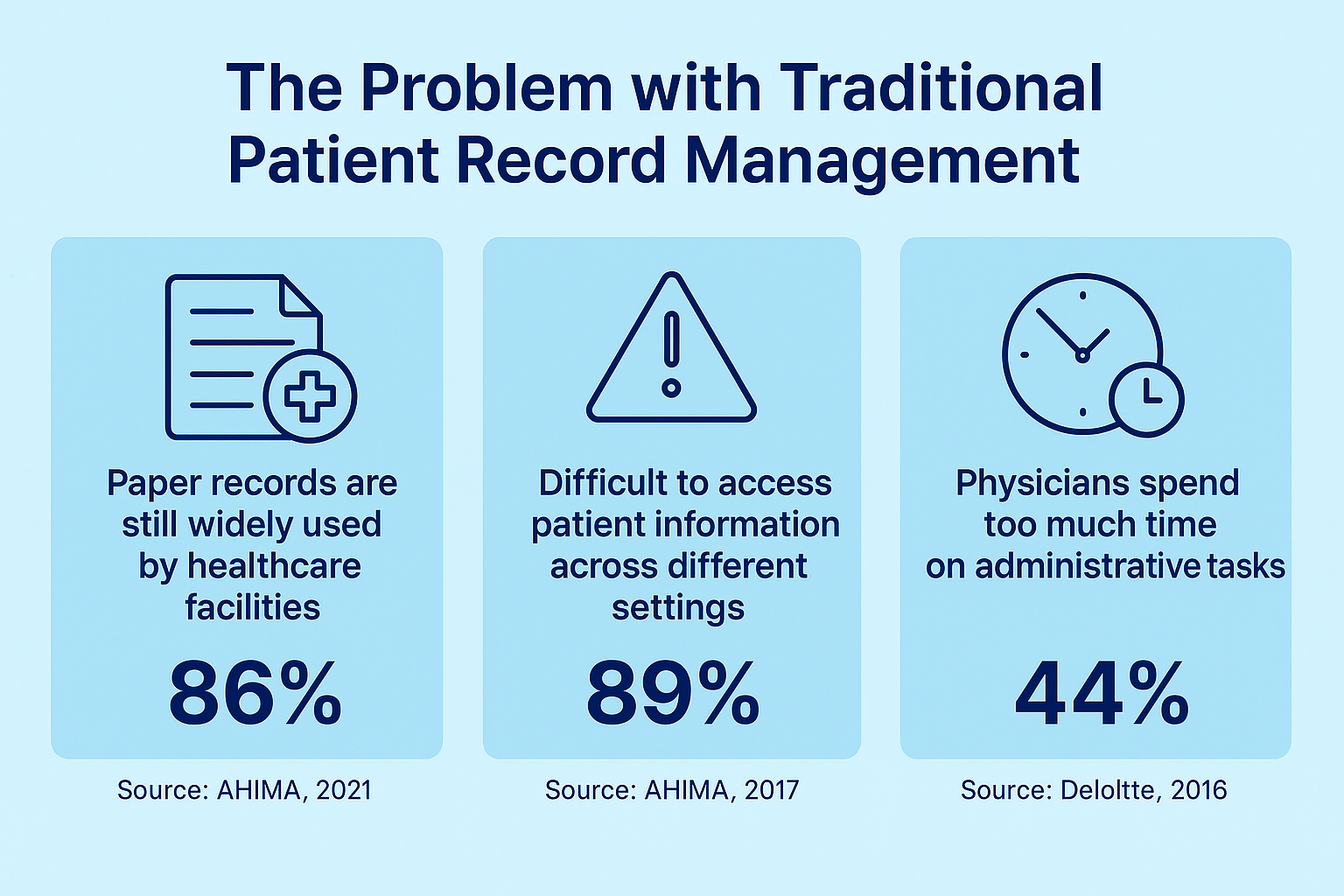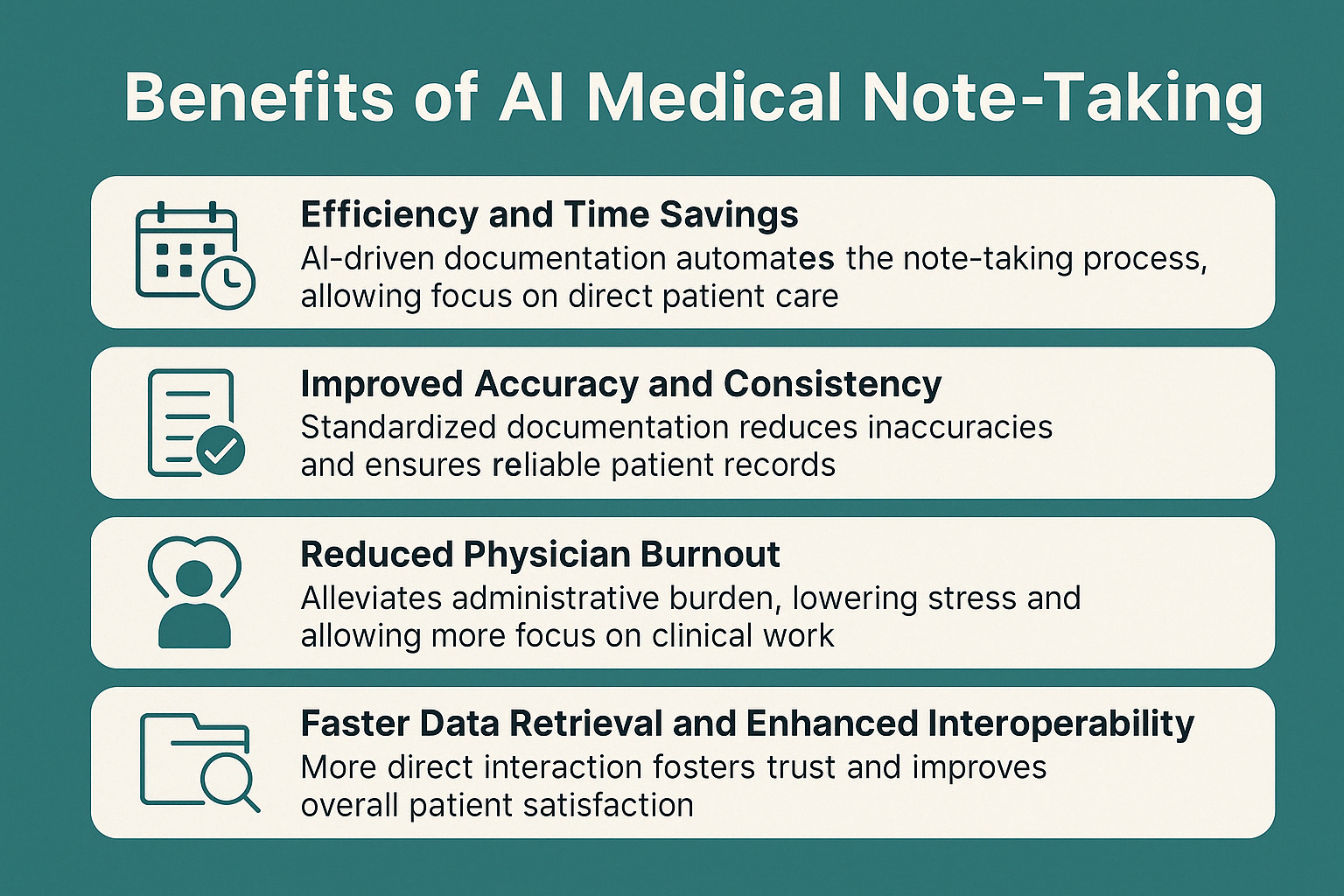Revolutionizing Patient Records with AI Note-taking

Imagine walking into your clinic and being met not by a stack of paperwork, but by the opportunity to focus more fully on your patients. Research shows that clinicians now spend more time documenting than engaging with those they care for (Ammenwerth and Spötl, 2009). This growing challenge has sparked a shift toward smarter solutions that support both efficiency and human connection. One of the most promising tools in this space is AI-powered medical note-taking.
By listening to clinical conversations and generating accurate, structured records in real time, AI notetaking helps providers reclaim time and reduce administrative burden. It enhances documentation quality, minimizes errors, and allows clinicians to concentrate on delivering better care. In this article, we explore how AI is reshaping patient record management, highlight key benefits and concerns, and consider the future of this transformative technology in clinical practice.
The Problem with Traditional Patient Record Management

For many healthcare professionals, manual documentation remains a time-consuming and often frustrating task. Long hours spent transcribing details, updating records, and ensuring accuracy can drain valuable clinical time. Even small errors or overlooked information can lead to inconsistencies in patient records that may impact care.
While Electronic Health Records were introduced as a breakthrough in healthcare modernization (Institute of Medicine, 2000), their implementation has not lived up to expectations. Studies have shown that EHR systems often add to the administrative burden through poorly designed interfaces and disjointed workflows, contributing to rising rates of clinician burnout (Shanafelt et al., 2016). In fact, clinicians are now spending up to half of their clinical time managing records instead of engaging with patients (Tai-Seale et al., 2017).
Inconsistent documentation quality adds another layer of difficulty. Without standardized notes, it becomes harder to retrieve vital information when it matters most. Together, the administrative load and variability in record-keeping not only pose risks to patient safety but also limit a provider’s ability to deliver personalized care. The need for a more efficient, reliable system is clear, and AI-powered notetaking is increasingly seen as a practical and powerful solution.
How AI Medical Note-Taking Works
AI medical note-taking uses advanced technologies like natural language processing (NLP) and machine learning (ML) to transform how patient encounters are documented. Below is a closer look at how this technology integrates into daily clinical workflows.
- Real-Time Voice Recognition and Transcription
During patient consultations, AI systems capture spoken interactions seamlessly. Using state-of-the-art voice recognition, the AI listens to conversations and transcribes them in real time. This allows providers to focus on the patient while the system generates structured notes in the background. NLP enables the AI to accurately interpret medical terminology and context, reducing the risk of transcription errors common with manual documentation.
- Seamless Transfer into Electronic Health Records
Once the conversation is transcribed, the notes are ready for immediate use and can be easily copied and pasted into your existing EHR system. This streamlined process eliminates redundant data entry and ensures that patient information is updated quickly and accurately. While not directly integrated, the simplicity of this approach still supports efficient documentation and allows providers to access reliable notes during consultations, leading to faster and more informed decisions.
- Continuous Learning and Customization
AI documentation systems improve over time by learning from provider feedback and corrections. With every interaction, the tool refines its transcription accuracy and adapts to individual documentation styles. This learning process reduces the need for manual editing and helps ensure the generated notes align with the provider’s workflow and preferences.
- Standardization and Compliance
AI-generated notes follow consistent, structured formats that support regulatory compliance, including HIPAA standards. Standardization improves interoperability across healthcare systems and supports more effective data sharing. This not only enhances clinical decision-making but also strengthens the foundation for long-term patient care planning.
Benefits of AI Medical Note-Taking

Adopting AI for medical note-taking offers a range of benefits that can elevate clinical workflows and patient care. Here are a few key advantages.
- Efficiency and Time Savings
AI-powered documentation helps reclaim hours that would otherwise be spent on manual data entry. By automating note-taking, you can dedicate more time to meaningful patient interactions. The result is a smoother workflow, reduced administrative pressure, and a more balanced workday.
- Improved Accuracy and Consistency
Manual notes often contain errors or omissions. AI enhances documentation quality by applying structured protocols, ensuring each note is complete and reliable. This consistency supports accurate diagnoses, better care decisions, and long-term patient safety.
- Reduced Physician Burnout
Administrative overload is a known driver of burnout. By easing the burden of documentation, AI allows you to refocus on clinical care. This shift improves professional satisfaction and helps sustain energy and focus across the workday.
- Better Patient Experience with Medical AI Note-Taking
When AI takes over the documentation, you can focus more fully on your patients. Increased face-to-face interaction allows for active listening and more responsive care. With fewer screen distractions, trust deepens and the experience becomes more personal. This shift strengthens the connection between provider and patient and supports a higher standard of care.
- Faster Data Retrieval and Enhanced Interoperability
AI-generated notes are structured and easy to navigate. This makes it simple to retrieve key details, review treatment history, and make informed decisions on the spot. The standardized format also improves data sharing between systems, helping providers across different settings stay aligned. In a collaborative healthcare environment, having consistent and accessible records is essential for safe and effective care.
Challenges and Ethical Considerations of AI Medical Note-Taking
While the benefits of AI in medical note-taking are clear, it is equally important to consider the challenges and ethical concerns that come with adopting this technology.
- Data Privacy and Security
Protecting sensitive patient information is essential. AI systems handle large volumes of private data, so strong security protocols must be in place. This includes encryption, secure transmission methods, and routine audits. Every AI tool should comply with privacy laws such as HIPAA and ensure that patient data remains protected at every step. As AI becomes part of clinical workflows, maintaining a balance between accessibility and confidentiality is critical.
- Accuracy and Bias
Even with modern language models, AI is not perfect. It can misinterpret clinical language, overlook important context, or reflect bias from its training data. These risks highlight the need for ongoing clinician oversight. AI-generated notes should always be reviewed and edited when necessary. Regular quality checks, system updates, and clinical accuracy studies are essential to keep the technology dependable and safe for use in real-world settings.
- Adoption and Trust
New technology often brings hesitation. Many clinicians remember the challenges of early electronic health record systems that were difficult to use and added to administrative burdens. Trust in AI will grow when tools are designed with clinicians in mind, perform reliably, and integrate smoothly into daily routines. Adoption improves when healthcare teams receive proper training and feel that the technology supports rather than disrupts their workflow.
The Future of AI in Patient Record Management
Looking ahead, the role of AI in healthcare documentation is set to grow rapidly. As machine learning continues to advance, AI tools will become more intuitive, more personalized, and more capable of supporting clinical decision-making.
- Advancements in Machine Learning
Future AI note-taking tools will likely benefit from more sophisticated learning capabilities, allowing them to better adapt to individual documentation styles. This continuous learning will not only improve transcription accuracy but also deepen the system’s understanding of clinical context, offering support that goes beyond simple documentation.
- Real-Time Clinical Decision Support
Imagine an AI system that listens, documents, and actively supports your clinical thinking in real time. As it processes patient data during the visit, it could highlight relevant history, suggest diagnostic considerations, or flag missing details. These tools will help you make faster, more informed decisions without disrupting your natural workflow.
- Enhanced Interoperability Across Healthcare Systems
The move toward connected care makes interoperability essential. Because AI-generated notes are structured and consistent, they are easier to share across hospitals, specialists, and other care providers. Better data sharing means more coordinated care, fewer gaps in treatment, and a more unified patient experience.
- Preventive and Predictive Care
AI’s ability to analyze trends across massive datasets could usher in a new era of predictive care. Future tools may spot early warning signs based on patterns in patient data, giving you the opportunity to intervene before a condition worsens. This shift toward proactive care will help improve outcomes and reduce long-term healthcare costs.
Conclusion
The rise of AI in medical note-taking marks a major turning point in how patient records are handled. By automating documentation, AI improves workflow efficiency, enhances accuracy, and eases the administrative burden that contributes to physician burnout. While concerns around data privacy, accuracy, and trust still require attention, the benefits are increasingly difficult to ignore.
Embracing AI gives you the chance to spend more time with patients, improve documentation quality, and contribute to a more efficient and collaborative healthcare system. Now is the time to explore how these tools can support your practice. Stay informed, stay engaged, and be part of shaping the next chapter in healthcare.
About the Author
Nathan Murray, M.D. Emergency Medicine - Founder of DocAssistant
Dr. Nathan Murray is an Emergency Medicine trained physician and the founder of DocAssistant. With years of frontline clinical experience, Dr. Murray is passionate about using AI to streamline medical documentation and enhance clinical decision making.



